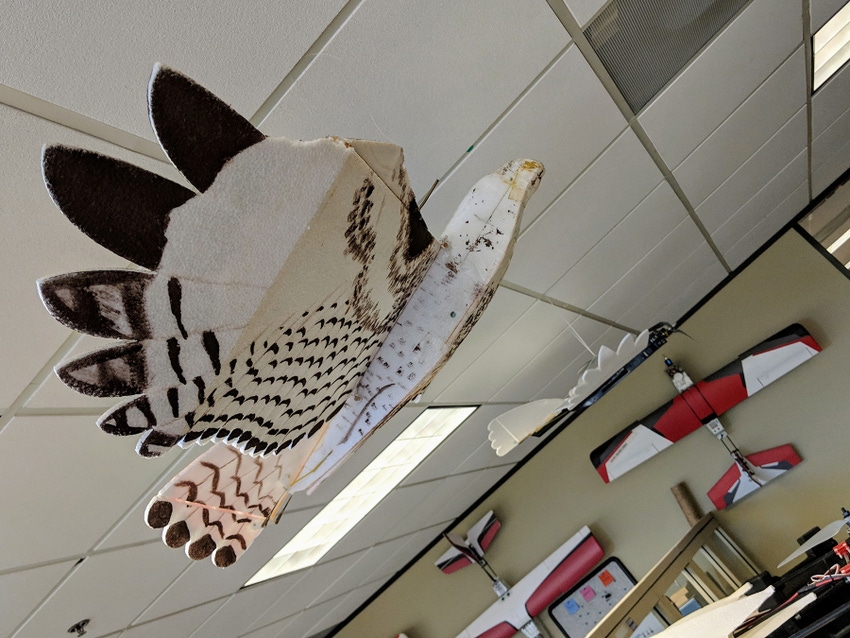
Drones are now a part of modern-day agriculture, keeping an eye-in-the-sky, watching from above. In one iteration, they’re disguised as birds, used by the Army as unobtrusive aerial observers and by farmers looking at predatory bird drones to scare away vineyard pests. The latest innovation is undergoing trials now in Australia as a means of scaring avians away from tempting grapes ripening on the vine.
Led by a 26-year-old mechanical engineering student at Sydney University School of Aerospace, Zi Wang is putting an unmanned aerial vehicle through its paces in South Wales vineyards. His drone has a dummy crow attached to the undercarriage and mimics bird behavior by emitting fake distress calls as it flies over the vines.
Utilizing a GPS system with an antenna and long-range telemetry radio, the aim of all this artifice is to detect the presence of birds in the vineyard and automatically launch in response, ostensibly scaring the birds away before they can land and attack the fruit.
Although conventional bird deterrents (auditory bird scarers and netting) remain a standard part of the warfare, estimated crop losses due to birds cause millions of dollars in damage annually and Wang says that early trials of his unmanned aerial vehicle (UAV) show it has the potential to “eliminate birds from vineyards.”
Bird drones have become a component in American agriculture under appropriate nomenclature such as ProHawk, Bird-X, Wine Haw3k, and other similarly-scary names (some of which are no longer manufactured).
Chicago-based pest control company Bird-X, established in 1964, called its ProHawk UAV ‘an alternative to scarecrows’ - “the first drone of its class made specifically for bird control combining a sonic bird repeller with the latest autonomous flight technology to patrol a predetermined area, regularly blasting a variety of menacing sounds to deter birds from approaching.”
Ostensibly, the ProHawk was supposed to look like a real-life raptor as it circled while emitting a variety of bird-harassing predatory and distress calls. The company noted: “The terrifying physical presence is heightened by sonic predator sounds.”
Made of carbon fiber construction, the ProHawk was designed to cover large areas and replace expensive falconers with limited availability. It followed a predetermined flight path and was capable of launching and landing on its own or controlled manually with long-range remote equipment allowing operators to hunt down flocks of birds before they got a chance to land and start eating lunch.
There is a land-based version called the Super BirdXPeller Pro that covers up to six acres with four speakers that blast a variety of naturally recorded distress and predator cries that confuse, disorient, and frighten away pest birds.
“We still work on humanely deterring birds from vineyards with electronic repellers, ultrasonic and sonic devices and holographic ribbon - but we no longer sell drones,” said marketing manager Rachel Cable.
Falcon drone
Clear Flight Solutions in the Netherlands has developed a drone that resembles a falcon. Called Robird, researchers are currently hazing birds at berry farms and European waste sites while they learn how best to use the technology. Says one research biologist: “Rather than just eliciting a flight response where the flock splits, then returns to the field, using drones to herd large flocks and keep them moving along their migration path might be a better strategy - rounding them up and pushing them in a different direction.”
Another firm, Precision Hawk in North Carolina - the first drone company to earn an FAA waiver for “beyond visual line of sight” flight - got its start in 2010 selling what they called Wine Hawk drones which were designed as bird-repelling aviators that prowled for pest birds.
Their drones became more sophisticated as collectors of data for crop protection and production, and the assessment of plant health analytics. The Wine Hawk ultimately got grounded in favor of its more intelligent siblings. “Although the drone was pretty good at keeping birds away, we quickly realized that platform was a more valuable mechanism to capture data,” said the company’s agricultural director, Bobby Vick.
Artificial predator birds in the form of drones have proven to be another tool in the tool box alongside traditional bird deterrents like netting, propane cannons, and pyrotechnics - a needed arsenal in an ongoing war, according to a USDA National Wildlife Research Center report showing that crows, blackbirds, and starlings alone were responsible for about $150 million in annual damage to fruit, berry, and grain crops in the U.S.”
To modify the old proverb about a bird in the hand somewhat, it’s just possible that a bird drone in the sky can be worth more than two in the bush. Does your vineyard future include a feathered flyover?
For more news on pests, disease management and other issues affecting vineyards, subscribe to the bi-monthly newsletter The Grape Line.
About the Author(s)
You May Also Like




